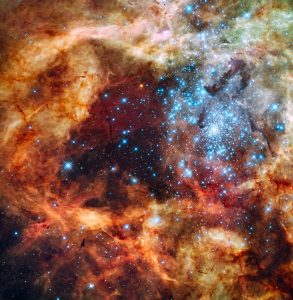The processes in the universe are never-ending. There seems no beginning and no end. Well, unless you accept the theory of the “Big Bang”, that everything started there – although the boffins are now suggesting a previous universe crushed itself into an “infinitesimal” point to start the process again. Anyway, to our way of thinking it helps to have a starting point, so we will choose nebulae. The word “Nebula” (plural nebulae) derives from the Latin meaning mist or cloud. These are the main star-forming regions of the universe.

Image Credit: NASA, ESA, and F. Paresce (INAF-IASF, Bologna, Italy), R. O’Connell (University of Virginia, Charlottesville), and the Wide Field Camera 3 Science Oversight Committee
It is a bit of a cliché that we are all made stardust. In any event it is not so much stardust as the dust of nebulae. In other words, our origin is rather nebulous, pun intended.
Nebulae are huge interstellar clouds of dust and gas, consisting of hydrogen (almost 90%), helium (almost 10%) and other ionised gases, which are forced to shrink and coalesce by gravity to form protostars. These bodies are cool but bright. As they collapse they release gravitational energy as radiation. We are unable to see these protostars, however, because they are usually shrouded in dust and only give off light in the far infrared part of the spectrum. Nebulae have about 1 000 particles per cm3, (which is a septillion times less than the air we breathe). A septillion is a trillion trillion, or 1024.
How stars reach their start-up mass is really a matter of chance. Under the influence of gravity material from a nebula starts clumping together at random. At a certain critical mass, as all the local debris, dust, loose atoms and stuff have been accumulated, a star might be born. It is estimated that no more than 10% of a nebula accumulates sufficient mass to form stars.
Nor is there a guarantee that the material clumping together will be enough to make this happen. Those less than a percent of the sun’s mass eventually halt their collapse due to gas pressure. They never ignite their hydrogen and so gradually fade out. These become brown dwarfs or giant planets like Jupiter.
A larger protostar continues the process. Over the next 100 000 years the protostar collapses under its own gravity. Its pressure and temperature increase until the cores reaches 167 000°C, the point at which fusion of hydrogen can begin. The hydrogen molecules are ionized (electrons are stripped from them), and they become single protons. Over the next half a million years the contraction of the gas and the rise in temperature continue until the star reaches about 10 million °C. The core has become so hot that it can sustain thermo nuclear fusion, and this gives it its heat and light. Gravity collects the star in the first place, then wants to crush it. But now the gravity is counter-balanced by the outward pressure of hydrogen fusion. This is when the star reaches equilibrium and enters a period of prolonged period of stability called the “Main Sequence” when the energy output is constant.
In this state a star can shine for trillions of years. It really depends on its initial mass. The greater the mass the shorter its life. Essentially there are three basic careers open to a star, once it gets going. With a solar mass of between 0.5 and 1.5 the star will last about 10 billion years in the main sequence before passing through the red giant stage and collapsing to a white dwarf. Above this mass are the supergiants, outside of the main sequence. Their lifespan is measured in terms of hundreds of thousands, maybe millions of years no more. At some stage they go supernova and end up as neutron stars or black holes. Stars below half a solar mass have a rather dim career, finally fading from sight. For even smaller candidates, say less than 0.08 solar mass they get no job at all, like our friend the Brown Dwarf.
[See the section on The Life Cycle of Stars].
Types of nebulae
There are many types of nebulae:
Emission nebulae
Reflection nebulae
Diffuse nebulae
Dark nebulae
Protoplanetary nebulae
Planetary nebulae
Supernova remnants
H-II Regions
Bok Globule
Back to Top
By Nigel Benetton, science fiction author of Red Moon Burning and The Wild Sands of Rotar.
Last updated: Sunday, 28th February 2021